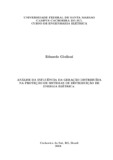| dc.contributor.advisor | Guarda, Fernando Guilherme Kaehler | |
| dc.creator | Giuliani, Eduardo | |
| dc.date.accessioned | 2019-03-29T14:23:22Z | |
| dc.date.available | 2019-03-29T14:23:22Z | |
| dc.date.issued | 2018-12-12 | |
| dc.date.submitted | 2018 | |
| dc.identifier.uri | http://repositorio.ufsm.br/handle/1/16011 | |
| dc.description.abstract | Currently, with the Normative Resolutions (RN - 482 and RN - 687) governed by the National Electric Energy Agency (ANEEL) and fiscal incentives for the insertion of renewable and non - renewable sources in the distribution system, small power plants located near consumption, known as Distributed Generation (GD), plays a fundamental role in the energy concept of a given location. They contribute to increasing generation capacity and also help by delaying investments in the expansion of distribution. Electric power distributors have a major challenge in designing and planning the protection,
operation and maintenance of their networks due to the migration of a previously unidirectional power flow system to a two-way system, all provided by a large This is facilitated by easy access to bank credits for independent energy producers. In this context, this work aims to analyze the influence of a source of GD (synchronous generator coupled through transformer) in the protection of electric energy distribution systems, and through the understanding of the protection philosophies adopted by the concessionaires, it will be possible to carry out simulations via software Powerfactory DigSilent . Possessing the results obtained through these simulations will be proposed solutions that can mitigate the problems found in them. Finally, it was possible to note that the insertion of GD causes an increase in the levels of short-circuit current, which leads to the coordination
between the recloser and the fuse link. To solve this problem, a solution was proposed using fault current limiters, where the result was satisfactory, returning the coordination between the protection devices. | eng |
| dc.language | por | por |
| dc.publisher | Universidade Federal de Santa Maria | por |
| dc.rights | Acesso Aberto | por |
| dc.subject | Geração distribuída | por |
| dc.subject | Proteção de sistema de distribuição | por |
| dc.subject | Sistema de distribuição de energia elétrica | por |
| dc.subject | Distributed generation | eng |
| dc.subject | Distribution system protection | eng |
| dc.subject | Electric distribution systems | eng |
| dc.title | Análise da influência da geração distribuída na proteção de sistemas de distribuição de energia elétrica | por |
| dc.title.alternative | Analysis of the influence of the generation distributed in the protection of electricity distribution system | eng |
| dc.type | Trabalho de Conclusão de Curso de Graduação | por |
| dc.degree.local | Cachoeira do Sul, RS, Brasil | por |
| dc.degree.graduation | Engenharia Elétrica | por |
| dc.description.resumo | Atualmente, com as Resoluções Normativas (RN - 482 e RN - 687) regidas pela Agência Nacional de Energia Elétrica - ANEEL (2012) e incentivos fiscais para inserção de fontes renováveis e não renováveis no sistema de distribuição, as pequenas centrais
geradoras localizadas próximas dos centros de consumo, conhecidas por Geração Distribuída (GD) tem um papel fundamental no conceito energético de um determinado local. Elas contribuem para o aumento da capacidade de geração e auxiliam também ao postergar investimentos na expansão da distribuição. As distribuidoras de energia elétrica têm um grande desafio para elaborar estudos e planejamento para as áreas de proteção, operação e manutenção de suas redes, devido a migração de um sistema de fluxo de potência anteriormente unidirecional para um sistema bidirecional, isto tudo proporcionado por um grande avanço nos empreendimentos desta natureza, fato este facilitado pelo fácil acesso a créditos bancários aos produtores independentes de energia. Neste contexto, este trabalho tem como objetivo analisar a influência de uma fonte de GD (gerador síncrono acoplado através de transformador) na proteção de sistemas de distribuição de energia elétrica, e através do entendimento das filosofias de proteção adotadas pelas concessionárias será possível realizar simulações via software Powerfactory DigSilent. R. De posse dos resultados obtidos através destas simulações serão propostas soluções que possam mitigar os problemas constatados nas mesmas. Por fim, foi possível notar que a inserção de GD causa um aumento dos níveis de corrente de curto-circuito, o que acarreta na perda de coordenação entre religador e elo fusível. Para solucionar esse problema, foi proposta uma solução utilizando limitadores de corrente de falta, onde o resultado apresentou-se satisfatório, retornando a coordenação entre os dispositivos de proteção. | por |
| dc.publisher.country | Brasil | por |
| dc.publisher.initials | UFSM | por |
| dc.subject.cnpq | CNPQ::ENGENHARIAS::ENGENHARIA ELETRICA | por |
| dc.publisher.unidade | UFSM Cachoeira do Sul | por |


